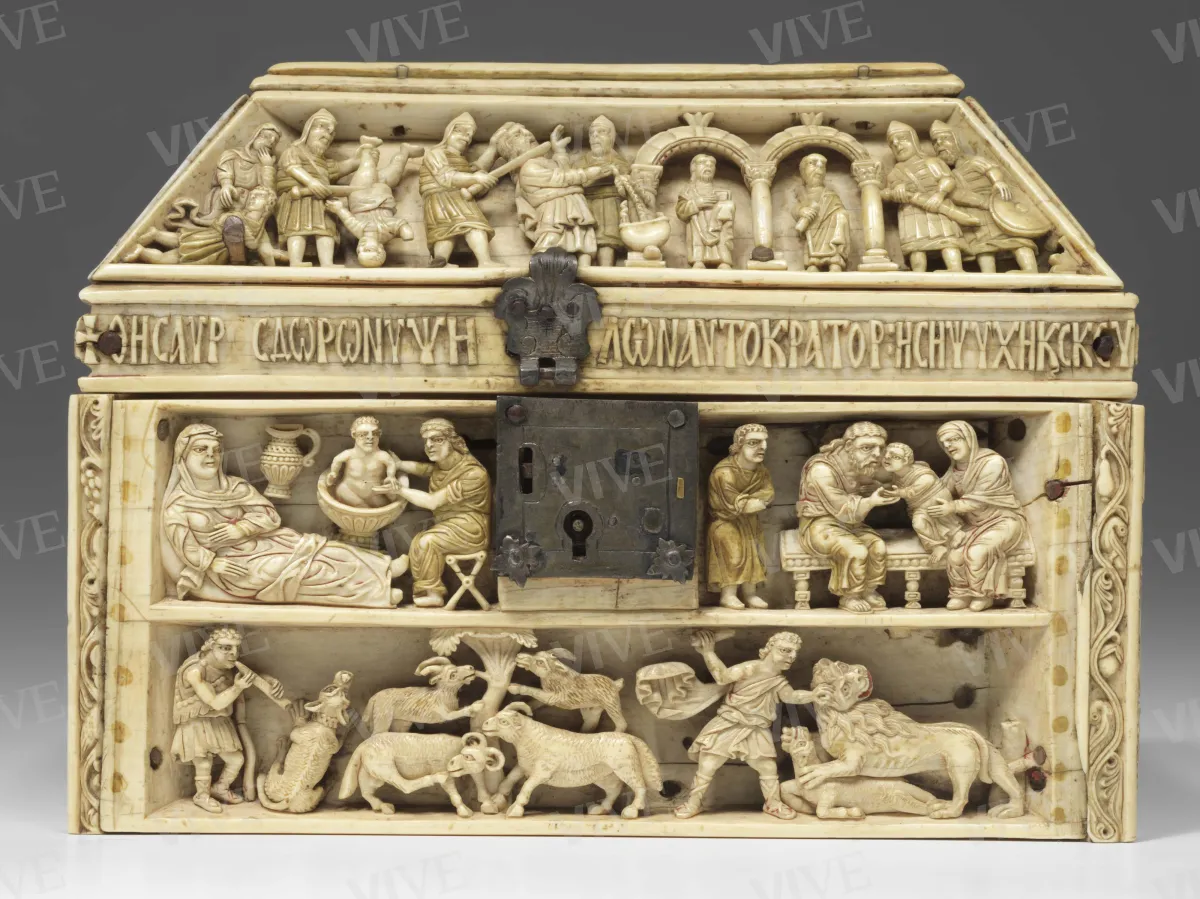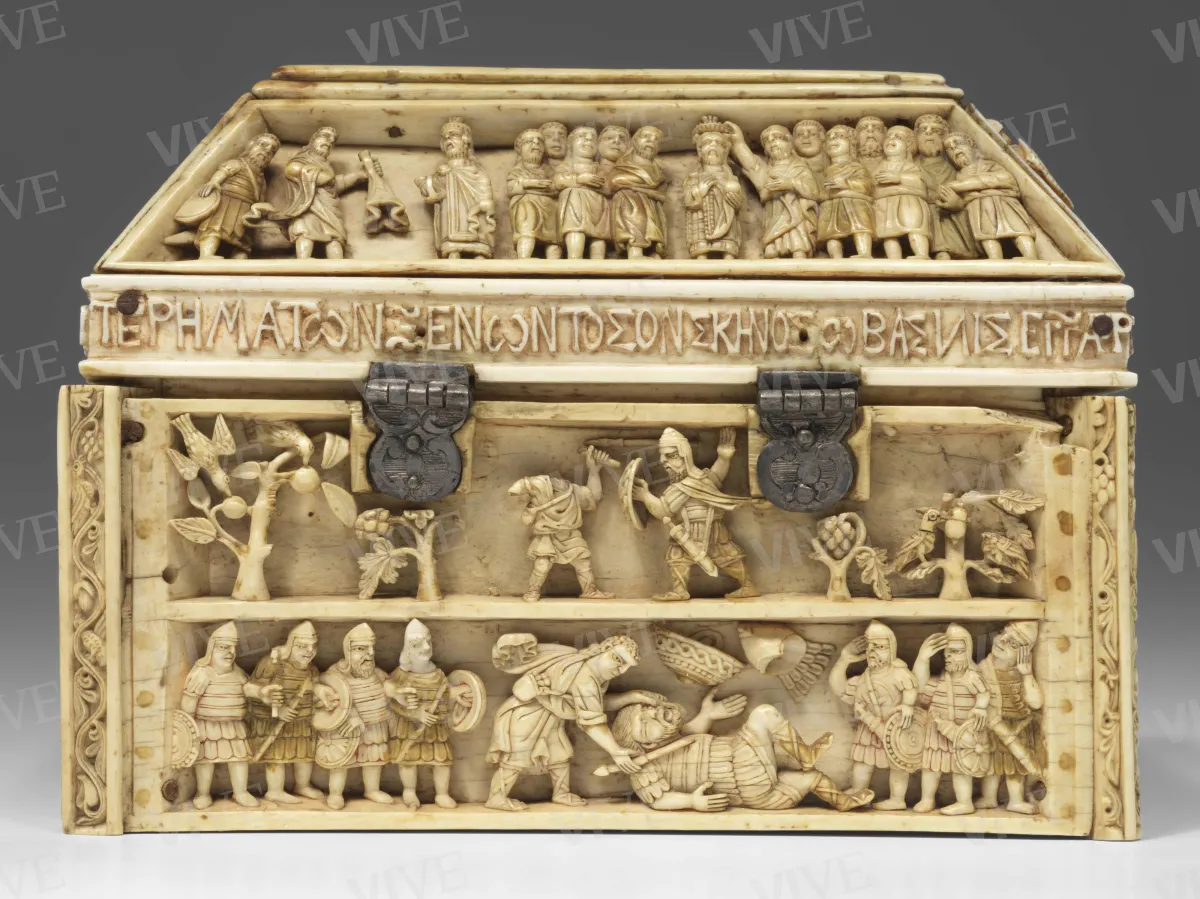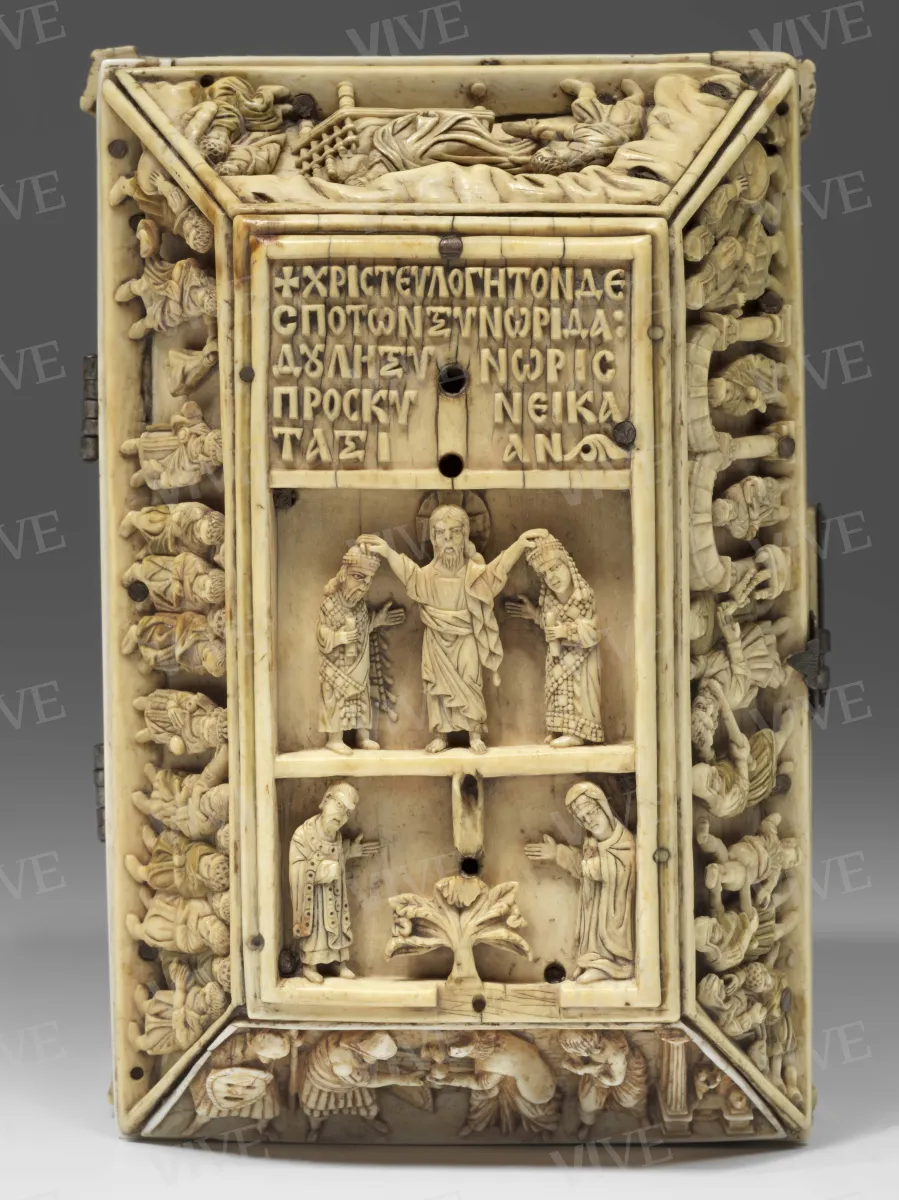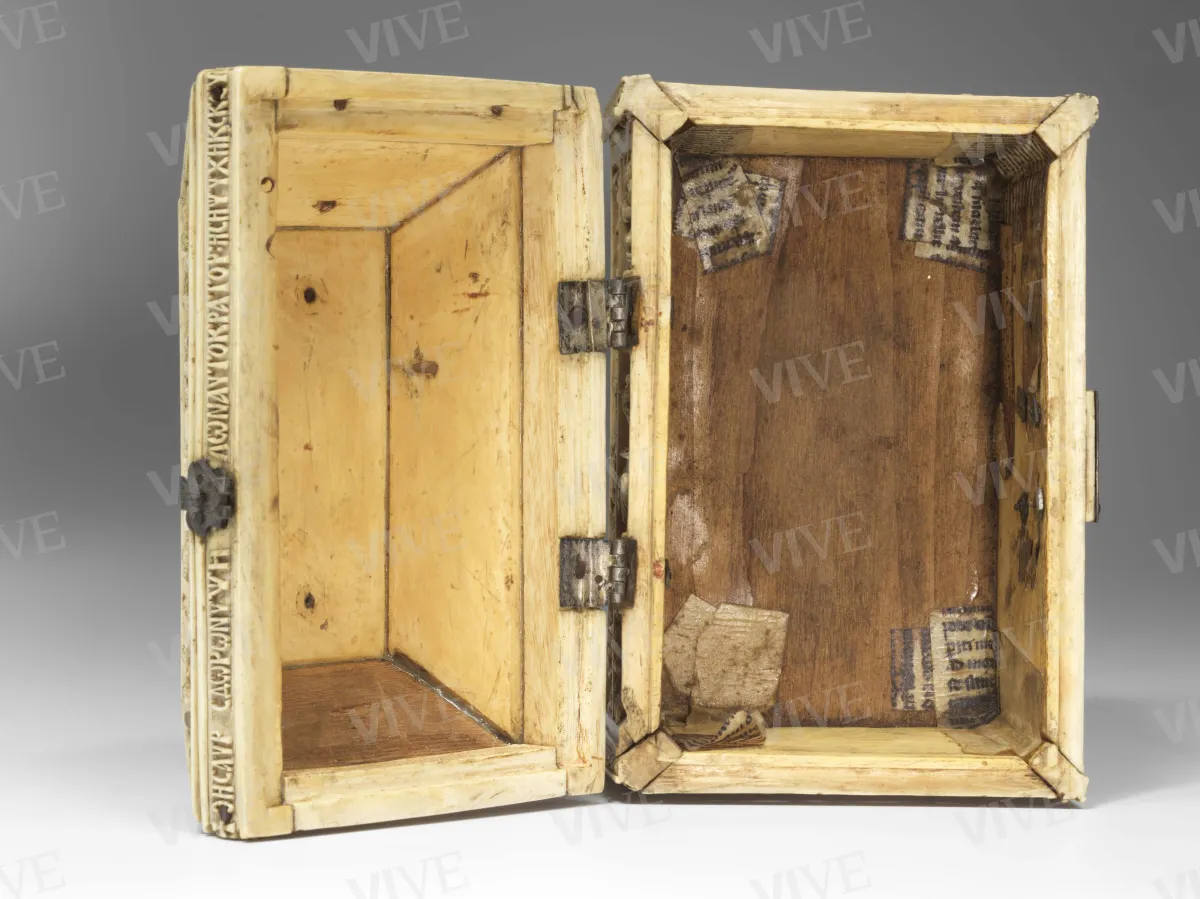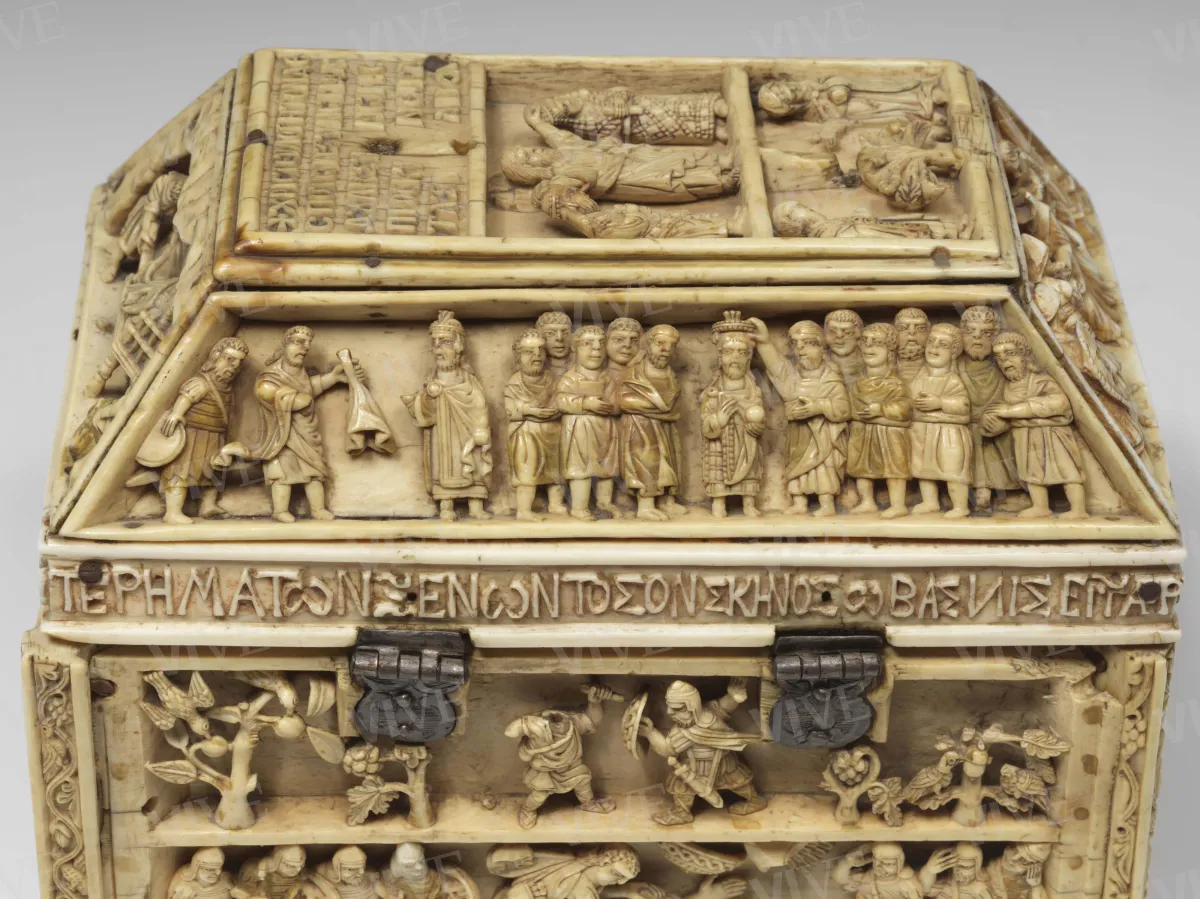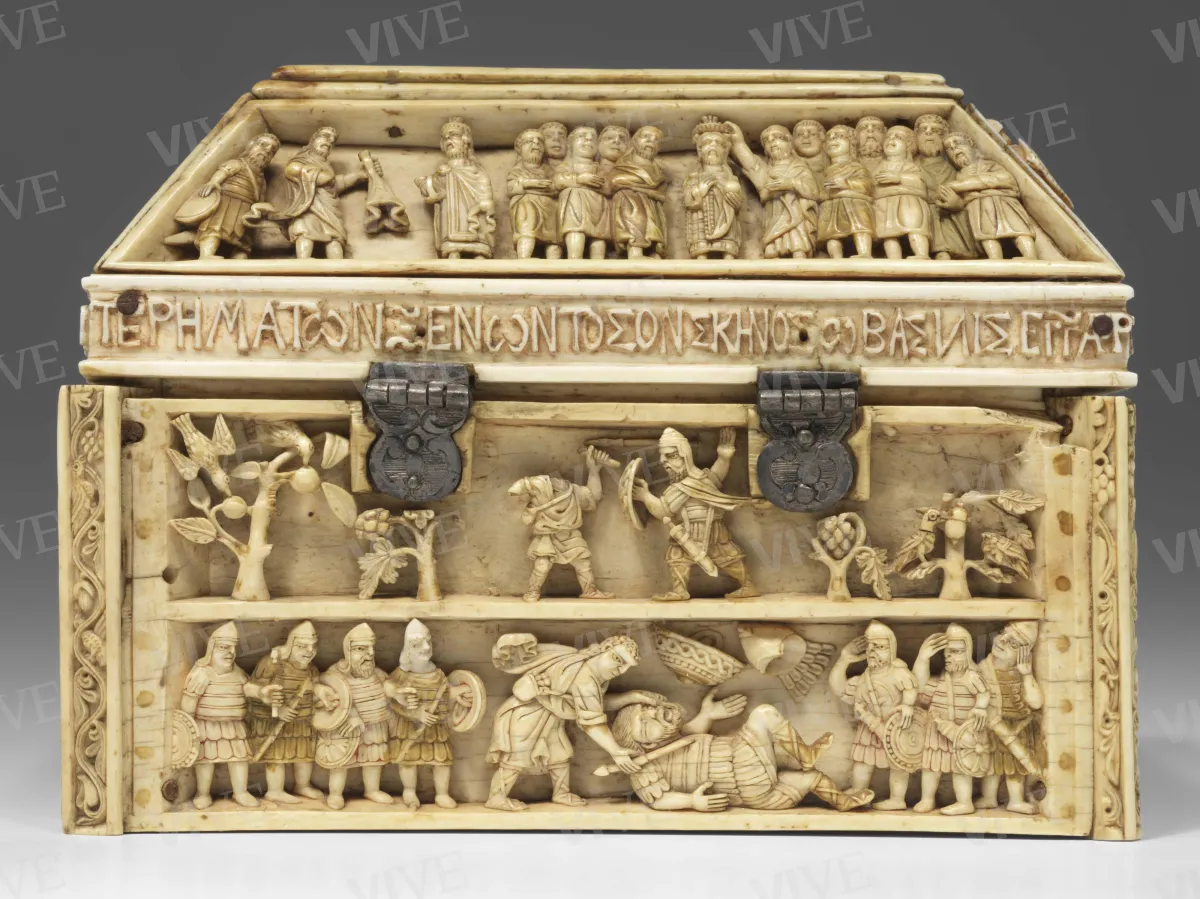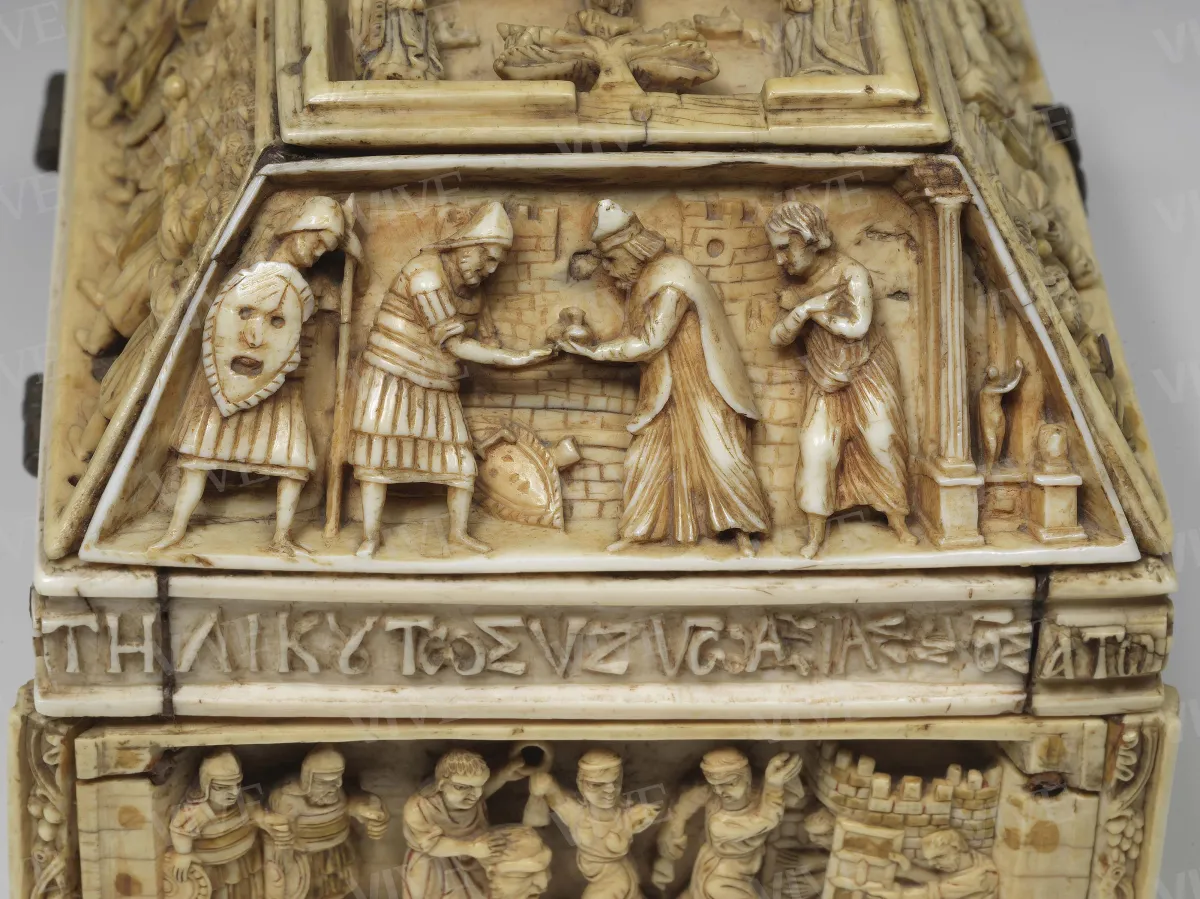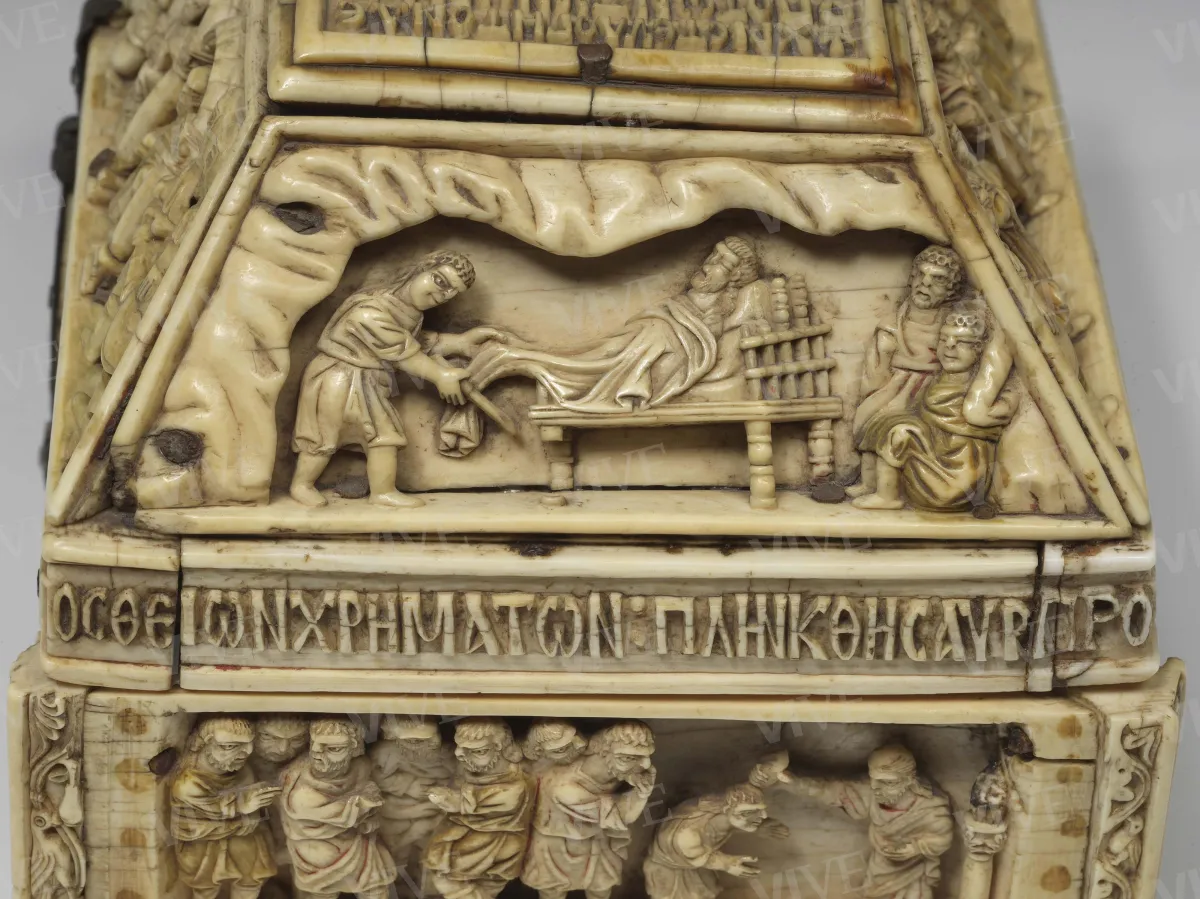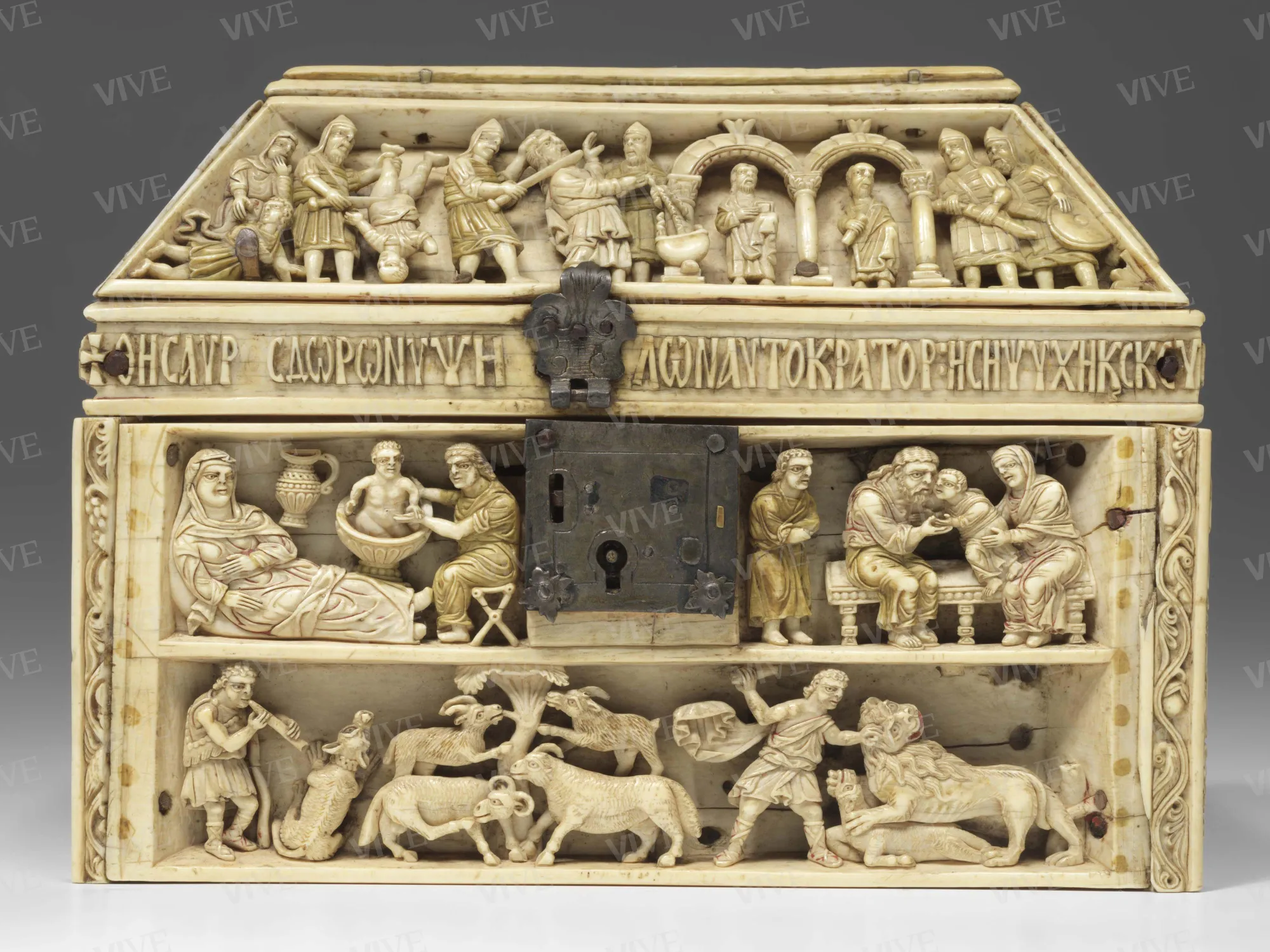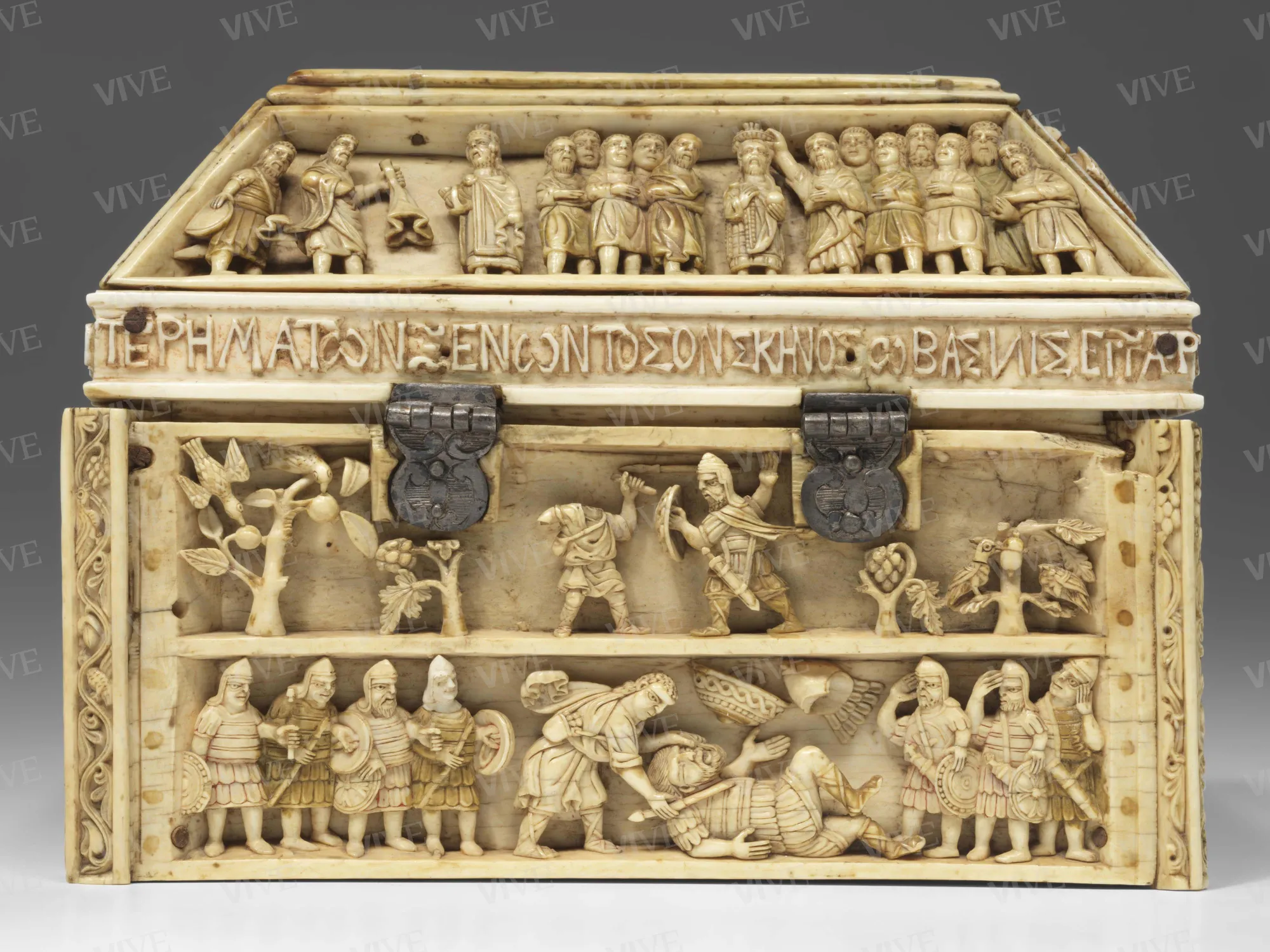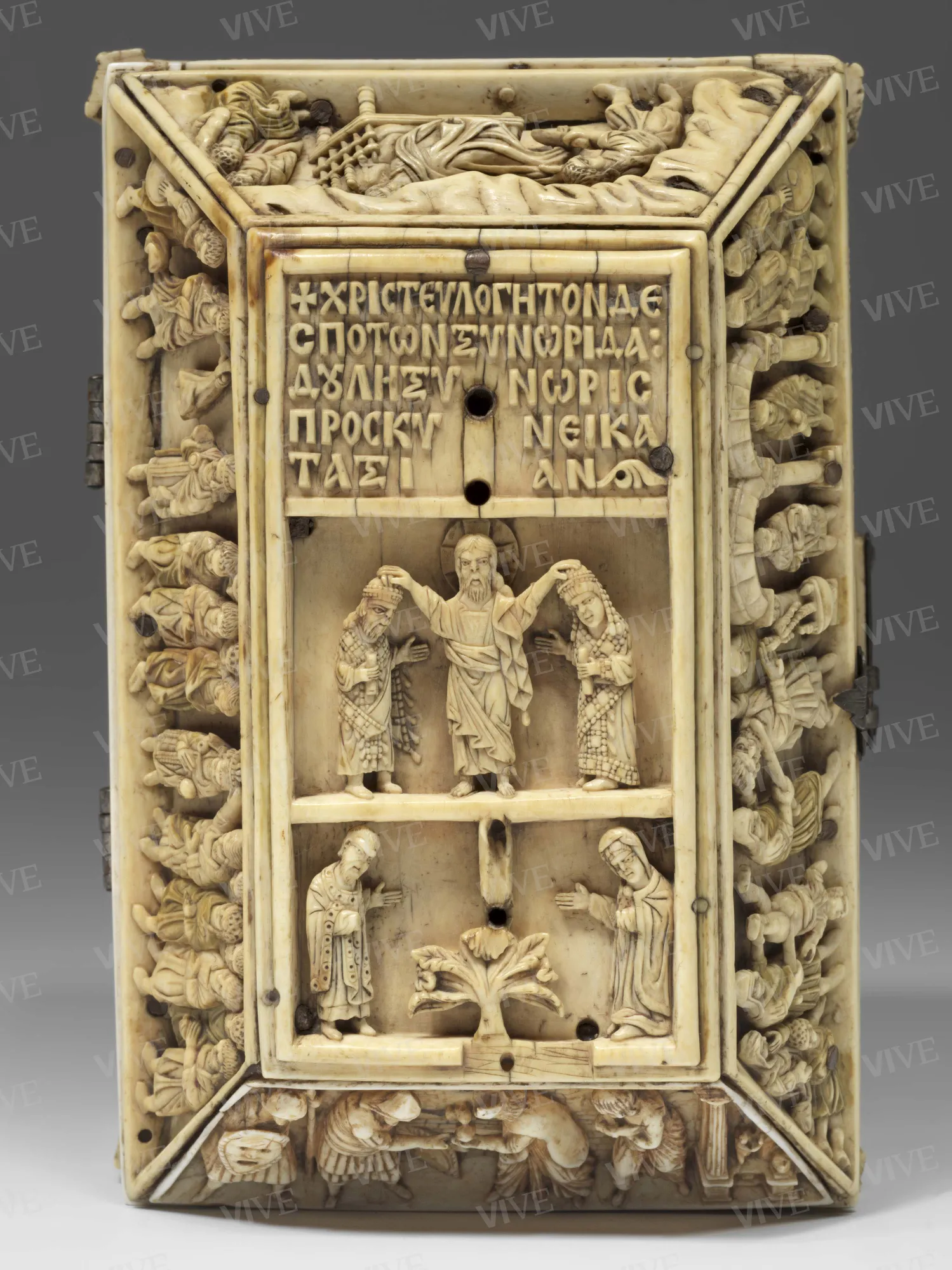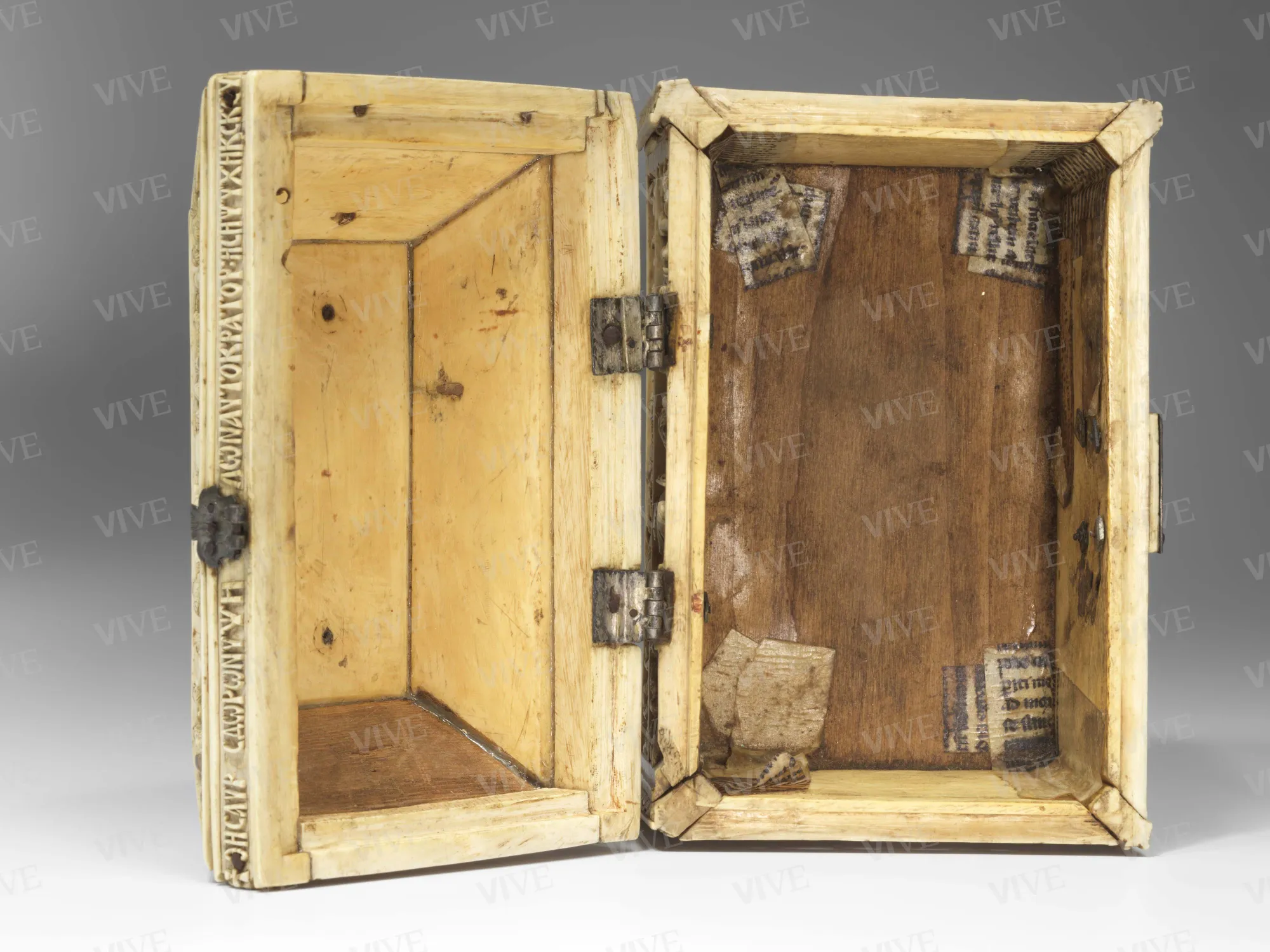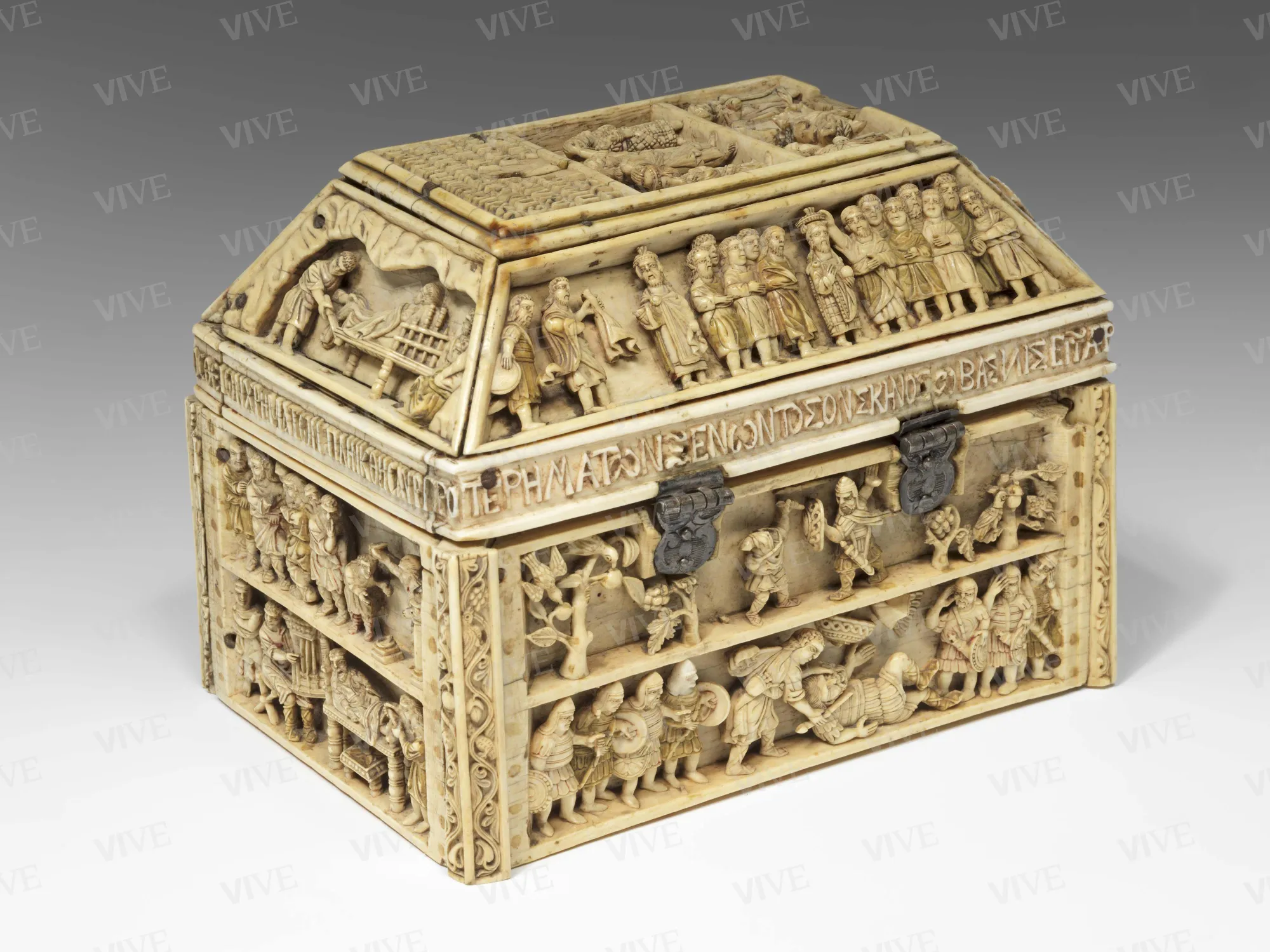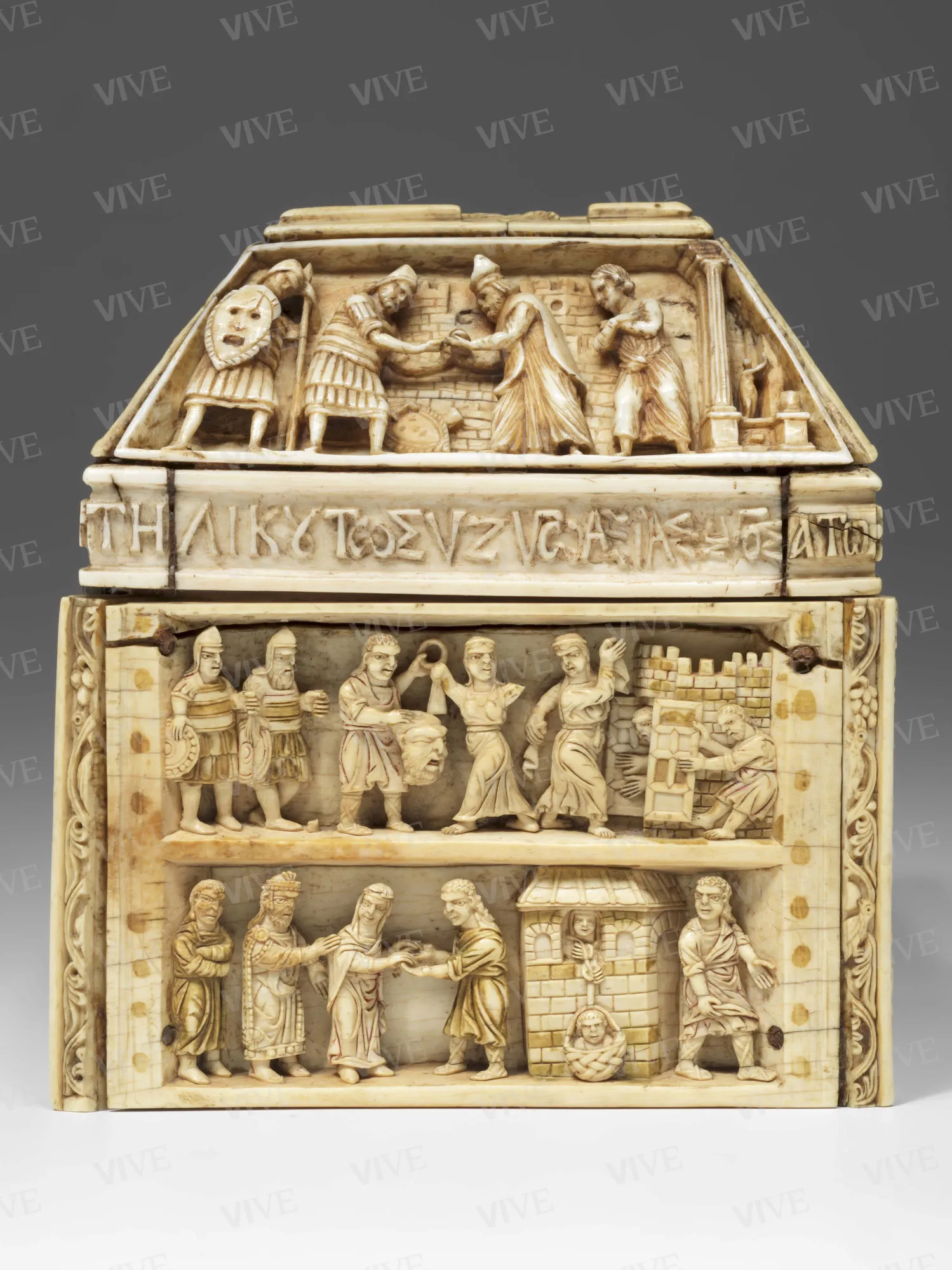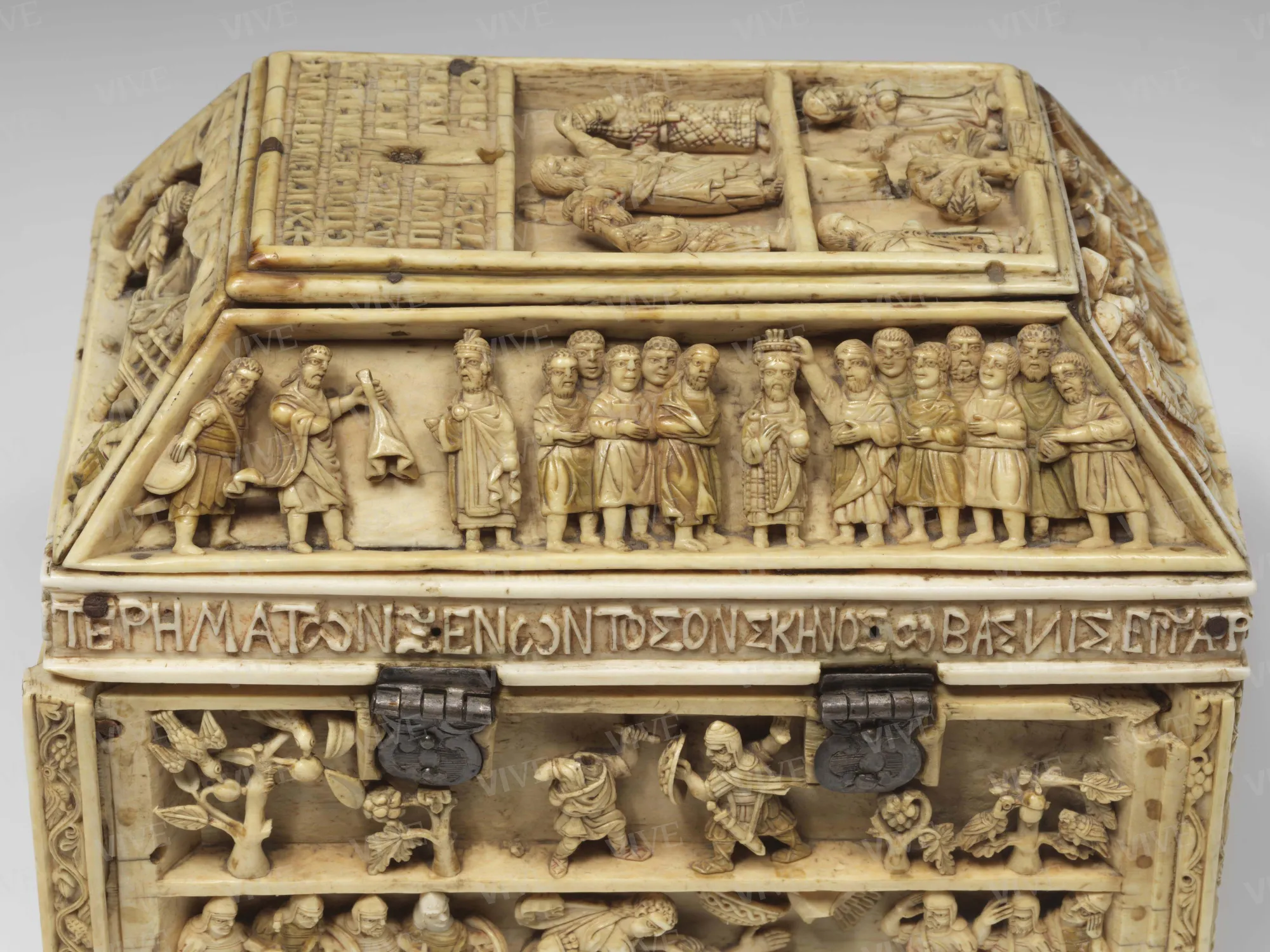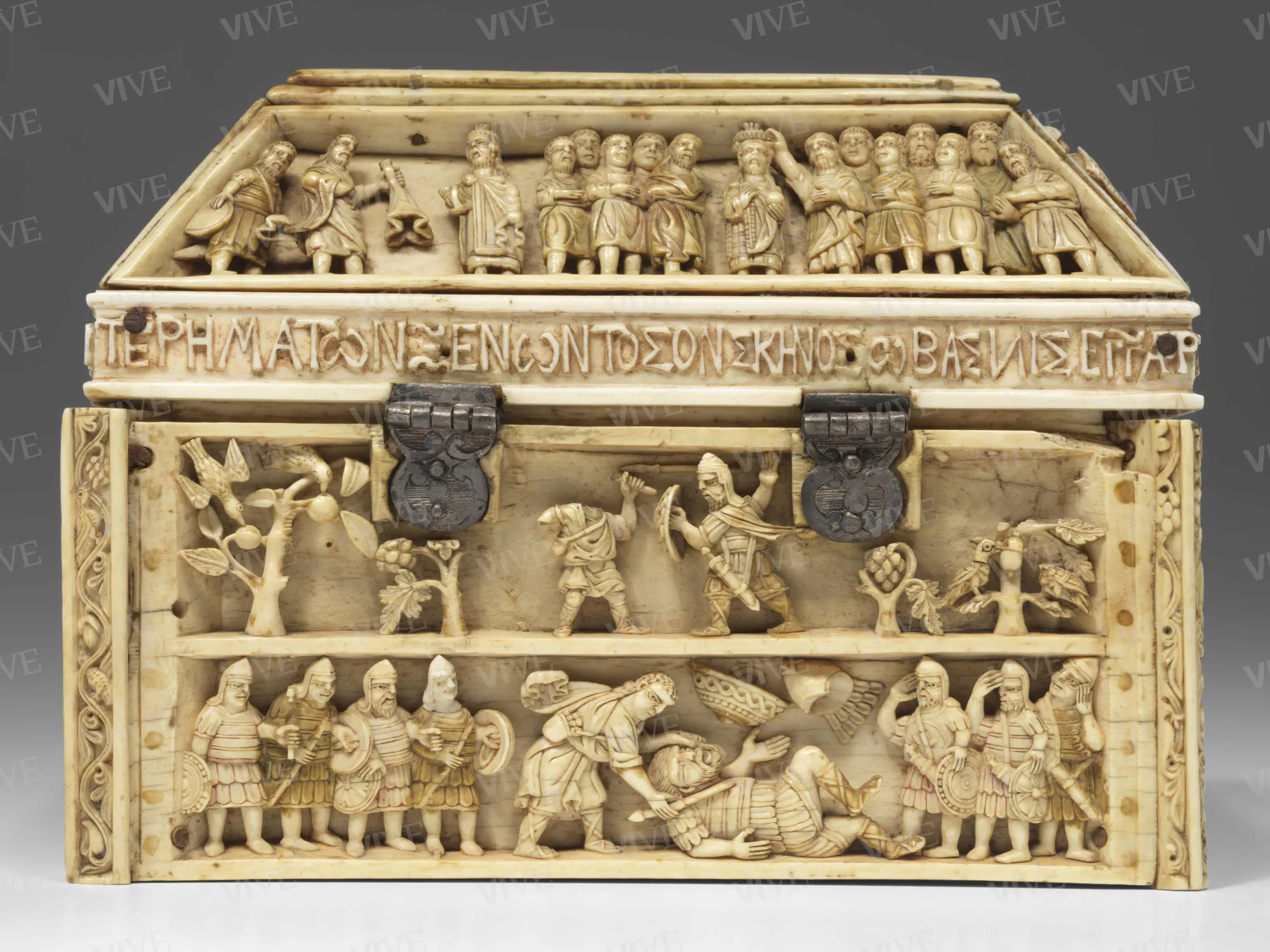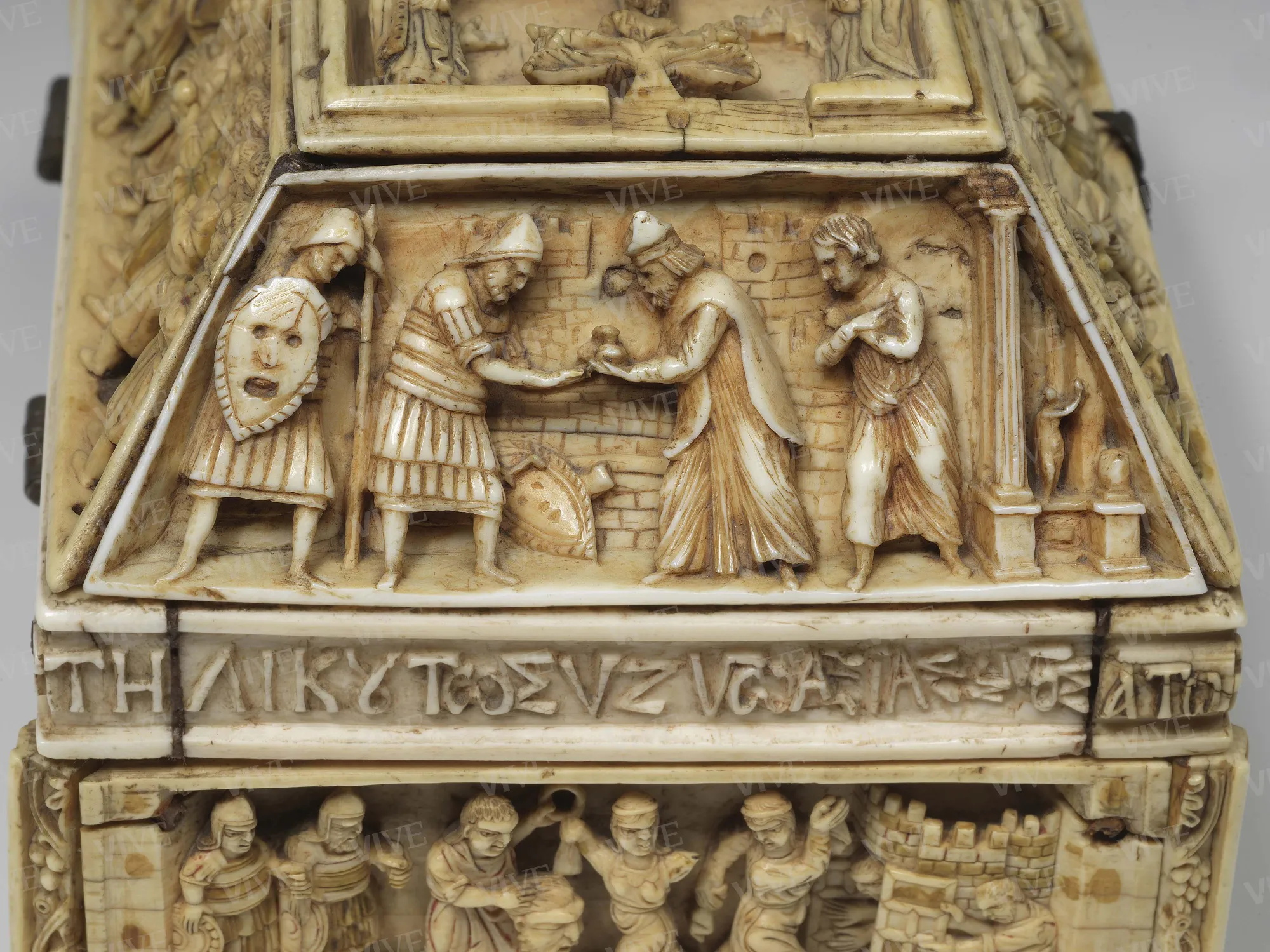Byzantine ivory casket with scenes from the life of David
Byzantine milieu End 9th–beginning 10th century
The carved ivory box has a parallelepipedon shape and is closed by a truncated pyramid-shaped lid with (non-original) hinges and lock. The four sides of the box and lid contain a cycle of stories from the life of David. The central plaque of the lid depicts an emperor and empress being crowned by Christ, with a second couple, possibly the patrons, in a lower section. The inscriptions on the lid and along the upper profile of the casket confirm that the work was originally conceived as a gift for a Byzantine imperial couple, probably at the turn of the ninth and tenth centuries.
The carved ivory box has a parallelepipedon shape and is closed by a truncated pyramid-shaped lid with (non-original) hinges and lock. The four sides of the box and lid contain a cycle of stories from the life of David. The central plaque of the lid depicts an emperor and empress being crowned by Christ, with a second couple, possibly the patrons, in a lower section. The inscriptions on the lid and along the upper profile of the casket confirm that the work was originally conceived as a gift for a Byzantine imperial couple, probably at the turn of the ninth and tenth centuries.
Details of work
Catalog entry
The casket consists of a parallelepipedon-shaped lower box and a truncated pyramid-shaped lid, which closes over the base thanks to two hinges and a small metal lock. Unlike other Byzantine era caskets known today, the one held by Palazzo Venezia is characterized by being made exclusively of panels of elephant ivory, grafted together by means of a complex interlocking system. The four sides of the box and the four trapezoidal panels of the lid contain a vast cycle of stories from the life of David taken from the first book of Samuel. The cycle consists of as many as fifteen scenes, from the prophet's birth (front side of the box) to his coronation (back side of the lid), and includes such celebrated episodes as David's fight against the lion (front side of the box) and the slaying of Goliath (back side). The reliefs are characterized by a very dynamic style, with large-headed figures, stocky torsos, and foreshortened limbs, depicted in lively and expressive poses. The considerable thickness of the ivory panels—as much as 8 millimeters in places—enabled the artists to achieve very pronounced three-dimensional effects, with frequent use of undercuts and great attention to detail in the architectural backgrounds, furniture, and accessories. The central lid panel is divided into three registers: the central register contains an imperial coronation scene, with Christ placing his hands over the crowned heads of an emperor (left) and an empress (right), depicted in court robes. Further down, a second couple in secular dress and ready for prayer is perhaps identifiable with the casket’s donor–couple, as, what’s more, the inscription in the upper register of the panel seems to declare, invoking divine blessing on the sovereigns. A second inscription, unfortunately only fragmentary, runs along the length of the upper edge of the box, and again celebrates the emperor (whose soul is described as a "treasure of sublime gifts") and the empress (whose body is described as a "treasure of marvelous qualities"). The absence of names or other dating clues within the inscriptions has led to a lively critical debate regarding the identity of the imperial couple who were the recipients of the casket, which was probably intended as a wedding gift. With rare exceptions, scholars are now inclined to identify the emperor as Leo VI (r. 896–912) and the empress as one of his four wives (perhaps Zoe, whom he married in 898); others, however, believe that the two are Basil I (r. 867–896) and his wife Eudocia Baiané.
The casket is officially attested to as part of the Kircherian Museum only from the late nineteenth century, and its earlier conservation history is unknown. At some unspecified time, however, the work was certainly subjected to radical restoration work, which involved the replacement of hinges and lock and the replacement of a portion of the inscription on the upper edge of the box (on the back and left sides), as well as the reconstruction of a soldier's head in the scene of the beheading of Goliath and of the entire panel depicting the encounter between David and Ahimelech. The Classical nature of these restorations, however, seems to suggest a culturally cognizant patronage, perhaps even the circle of Athanasius Kircher himself, whose home, it cannot be excluded, might have housed the casket from the seventeenth century. At Castel Sant'Angelo after the dispersion of the Kircherian Museum, the work then became part of the collections of the Palazzo di Venezia in 1920.
Giovanni Gasbarri
Entry published on 12 February 2025
State of conservation
The ivory panels that make up the casket are cracked in several places, and some of the details on the reliefs have been lost. A substantial part of the inscription on the upper edge, as well as the left plaque of the lid (depicting David and Ahimelech) are the result of re-elaboration/replacement, perhaps dating from the seventeenth century, a period to which the present hinges and lock may also date. A series of holes for a handle (now missing) can be made out on the lid. Residual traces of polychrome can also be seen.
Inscriptions
Cover: “+ΧΡΙΣΤΕΥΛΟΓΗΤΟΝ ΔΕ/ΣΠΟΤΩΝ ΞΥΝΩΡΙΔΑ: / ΔΟΥΛΗ ΞΥΝΩΡΙΣ / ΠΡΟΣΚΥΝΕΙ ΚΑ / ΤΑΞΙΑΝ”;
top edge of casket: “ΘΗΣΑΥΡ[Ο]Σ ΔΩΡΩΝ ΥΨΗΛΩΝ ΑΥΤΟΚΡΑΤΟΡ: Η ΣΗ ΨΥΧΗ Κ[ΑΙ] ΣΚΕΥΟΣ ΘΕΙΩΝ ΧΡΗΜΑΤΩΝ ΠΛΗΝ Κ[ΑΙ] ΘΗΣΑΥΡ[ΟΣ] ΠΡΟΤΕΡΗΜΑΤΩΝ ΞΕΝΩΝ ΤΟ ΣΟΝ ΣΚΗΝΟΣ Ω ΒΑΣΙΛΙΣ [....] ΤΗΛΙΚΟΥΤΩ ΣΥΖΥΓΩ [...] ΑΤΩ”.
Provenance
Rome, Kircherian Museum, documented from 1870;
Rome, Museo di Castel Sant'Angelo, from 1913;
Rome, Museo Nazionale di Palazzo Venezia, from 1920.
Exhibition history
Parigi, Musée des Arts Décoratifs, Bibliothèque Nationale, Exposition internationale d’art byzantin, May 28–July 9 1931;
Ravenna, Chiostri Francescani, Mostra degli avori dell’Alto Medio Evo, September 9–October 21 1956;
Edinburgh, Royal Scottish Museum; London, Victoria and Albert Museum, Masterpieces of Byzantine Art, August 23–November 9 1958;
Rome, Museo Nazionale di Palazzo Venezia, Athanasius Kircher. Il museo del mondo, February 28–April 22 2001;
Rome, Museo Nazionale di Palazzo Venezia, Cipro e l’Italia al tempo di Bisanzio. L’icona grande di San Nicola tis Stégis del XIII secolo restaurata a Roma, June 23–July 26 2009.
References
Goldschmidt Adolph, Weitzmann Kurt, Die byzantinischen Elfenbeinskulpturen des X. - XIII. Jahrhunderts, I, Kästen, Berlin 1930, pp. 63-64, n. 123;
Diehl Charles (a cura di), Exposition internationale d’art byzantin, catalogo della mostra (Parigi, Musée des Arts Décoratifs, Bibliothèque Nationale, 28 maggio-9 luglio 1931), Paris 1931, n. 86;
Bovini Giuseppe, Bona Ottolenghi Luisa (a cura di), Mostra degli avori dell’Alto Medio Evo, catalogo della mostra (Ravenna, Chiostri Francescani, 9 settembre-21 ottobre 1956), Faenza 1956, n. 108;
Talbot Rice David (a cura di), Masterpieces of Byzantine Art, catalogo della mostra (Edimburgo, Royal Scottish Museum; Londra, Victoria and Albert Museum, 23 agosto-9 novembre 1958), Edinburgh 1958, n. 121;
Cutler Anthony, Oikonomides Nicholas, An Imperial Byzantine Casket and Its Fate at a Humanist’s Hand, in «Art Bulletin», 70, 1988, pp. 77-87;
Maguire Henry, The Art of Comparing in Byzantium, in «Art Bulletin», 70, 1988, pp. 88-103;
Lo Sardo Eugenio (a cura di), Athanasius Kircher. Il museo del mondo, catalogo della mostra (Roma, Museo Nazionale del Palazzo Venezia, 28 febbraio-22 aprile 2001), Roma 2001 n. I.3;
Elides Ioannis (a cura di), Cipro e l’Italia al tempo di Bisanzio. L’icona grande di San Nicola tis Stégis del XIII secolo restaurata a Roma, catalogo della mostra (Roma, Museo Nazionale di Palazzo Venezia, 23 giugno-26 luglio 2009), Nicosia 2009, n. 1;
Moretti Simona, Roma bizantina. Opere d’arte all’impero di Costantinopoli nelle collezioni romane, Roma 2014, pp. 221-225;
Galardi Elisa, The David Casket: A Gift for the Byzantine Empress, in «Cahiers Archéologiques», 20, 2022, pp. 20-37;
Gasbarri Giovanni, A King, a Priest, and (Maybe) an Idol: The David Casket and Its Afterlife in Rome, in «Arte Medievale», s. IV, 13, 2023.

